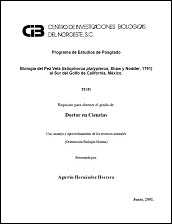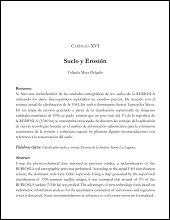Florística de la Selva Baja Caducifolia de la Península de Baja California, México
Autor
JOSE LUIS LEON DE LA LUZ
REYMUNDO DOMINGUEZ CADENA
ALFONSO MEDEL NARVAEZ
Metadatos
Mostrar el registro completo del ítemResumen
"Los objetivos de este trabajo fueron integrar el listado florístico de la selva baja caducifolia en la península de Baja
California y delimitar su presencia. Esta comunidad vegetal ocupa una superficie de 3,325 km2
en el extremo sur peninsular, que
se ha propuesto como la versión más seca de las selvas bajas en México. Después de décadas de esfuerzos, actualmente se considera
que su composición florística está adecuadamente representada en el herbario del Centro de Investigaciones Biológicas del
Noroeste. El listado cuenta con 645 taxa de plantas superiores y de ellos 37 son endémicos. Con base en muestreos de campo, se
discute la composición florística de los dominantes ecológicos de esta comunidad. Sobresale Lysiloma microphyllum como especie
indicadora de este tipo de vegetación. En el análisis de las formas de crecimiento, se resalta el de las trepadoras, cuyo número
es similar al registrado para el desierto Sonorense y comunidades contiguas, pero notablemente inferior al de otras selvas bajas
caducifolias del sur de México." " The objective of this research was to prepare a floristic list of the tropical dry forest in Baja California Peninsula and to
delimit its coverage. This forest covers 3,325 km2
in the mountainous southernmost part of the peninsula; this community is the
driest version of its type in Mexico. After decades of fieldwork, the representation of the flora in the herbarium of the Centro de
Investigaciones Biologicas is almost complete. There are 645 taxa of vascular plants, of which 37 are endemics to this area. The
authors discuss the floristic composition of the ecologically dominant plants based on field surveys. Lysiloma microphyllum is the
most important species in this vegetation community. Using growth form analysis, we found that climbers have a proportional
frequency similar to that of the Sonoran Desert flora and neighboring communities, but are significantly less than other dry tropical
forests in southern Mexico"
Colecciones
Ítems relacionados
Mostrando ítems relacionados por Título, autor o materia.
-
PROMOCIÓN DEL PERIFITON PARA EL CULTIVO DE CAMARÓN BLANCO: HACIA UNA ACUICULTURA ECOLÓGICA
DOMENICO VOLTOLINA LOBINA; JUAN MANUEL AUDELO NARANJO; MARIA DEL ROSARIO PACHECO MARGES -
Suelo y Erosión
YOLANDA LOURDES MAYA DELGADO


